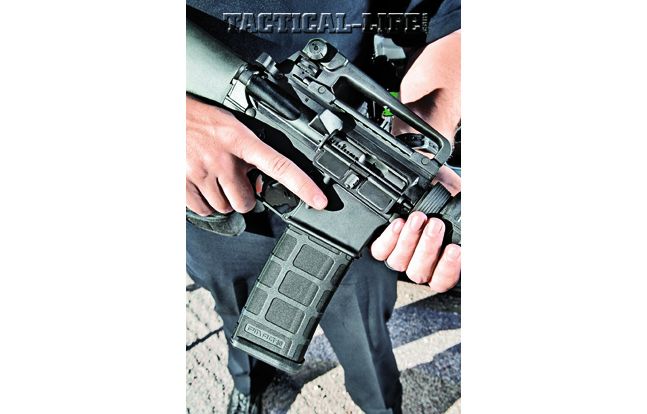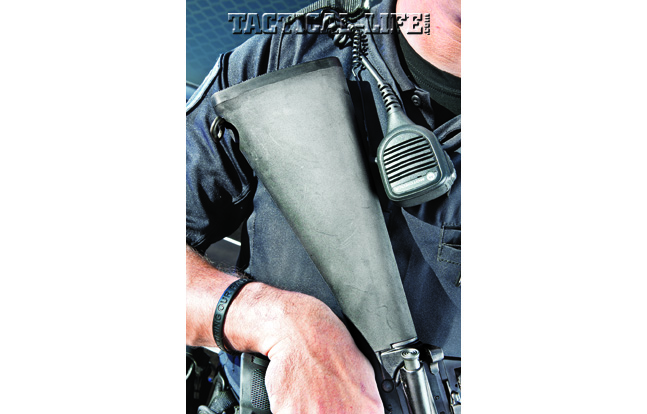Since Colt bought the rights to produce the U.S. military’s M16 in the late 1950s, the names Colt and M16/AR-15 have been connected in the minds of most folks, in pretty much the same way many interchange “Colt .45” and “1911.” Love it or hate it—and there are a lot of people who have used the M16/AR-15 family at some point that fall into either camp—the platform has morphed a lot since the first rifles left the Colt plant and landed in Vietnam.
Following an ignominious beginning, abused by a number of missteps that led to the rifles’ less-than-stellar introductory performance, the M16A1 overcame it all to gain wide acceptance. But, as mentioned, the rifle has changed over the years, with the most recent modifications initiated during the wars in Iraq and Afghanistan. And the result is a highly refined weapon system that has also found a home in the domestic law enforcement community.
Accepted today as one of the finest rifles used in modern warfare, the M16/AR-15 platform can be had with collapsible stocks of all varieties for any need, differing barrel lengths, swappable barreled upper assemblies, handguards with more rails than a train yard or more traditional polymer versions, and just about any accessory anyone might want to add after the fact. Colt ships ARs that fall into just about every group.
Advertisement — Continue Reading Below
Colt also ships quite a few rifles with a close resemblance to the ones Eugene Stoner developed and the guys of the Vietnam era carried—today’s M16A4. There are differences, of course, but the general outline is there. Far from being obsolete, a rifle with a fixed stock is still valued by a number of military customers, including the U.S. Marine Corps.
Over the years, the USMC seems to have been a driving force behind many of the platform’s changes—the M16A2 and M16A4, for example. Of course, the Marines still believe “all Marines are riflemen,” providing their focused viewpoint on the purpose of individual weaponry. The best figures I could find indicated the Corp has around 300,000 M16A4s and M4s on hand, with the latter accounting for less than 30 percent of the total.
Why such a bias for the M16A4-pattern rifle? Marines believe the increased sight radius from the longer 20-inch barrel, over the M4’s 14.5-inch barrel, provides for greater shooter accuracy using iron sights, improves the velocity and lethality of the 5.56mm NATO round, and increases its usable range. And, these characteristics also make it a good choice for law enforcement officers.
Advertisement — Continue Reading Below
Continue Reading: Colt AR-15A4 5.56mm Rifle | Gun Review

Gun Details
This article’s focus is Colt’s non-military version of the M16A4, the AR-15A4. Primarily, the difference between the M16A4 and the AR-15A4 comes down to the former’s capability for automatic (three-round burst, actually) fire—i.e., a three-position selector switch. The AR-15A4 is strictly a semi-automatic. Both still include M4 feed ramps for an increased level of confidence.
Advertisement — Continue Reading Below
What does the AR-15A4 have that its grandfather several times removed, the M16A1, being drug through the jungles of Vietnam, did not have, excluding the M16’s military trigger system differences? Both sport fixed, glass-filled polymer stocks, polymer handguards (triangular on the earlier versions, round on the A4) with aluminum heatshields, black hardcoat anodized 7075-T6 aluminum alloy receivers, forward assists, front sight towers (with elevation-adjustable sight posts, square on the A4) and carry handles containing the adjustable rear sight (windage and elevation adjustable on the A4). However, the carry handle on the A4 is removable, leaving the Picatinny rail commonly found on flattop upper receivers ready for adding optics, sights and accessories.
Bores in their 20-inch, Parkerized steel barrels are chrome lined, with earlier models having 1-in-12- or 1-in-14-inch twist rates, while the A4 has a 1-in-7-inch twist rate for stabilizing heavier bullets. Modern barrels also have slightly heavier profiles outside the handguards for improved strength, trimmer profiles beneath the handguards, M203 grenade launcher cutouts and M4 feed ramps.
The operating system of both rifles (direct gas impingement) and weight (around 7.7 to 7.9 pounds) will be about the same, although the A4 family includes an ambidextrous selector switch. Unlike the M16A1, A4s utilize the more-ergonomic A2-style pistol grips with finger grooves. The flash suppressor does not have holes in the bottom, reducing dust kick-up when shooting prone.
Advertisement — Continue Reading Below
Continue Reading: Colt AR-15A4 5.56mm Rifle | Gun Review

Range Time
Shooting the AR-15A4 was an interesting change from the M4-style carbines that have predominated in my testing recently. I could see how shifting the balance of the longer rifle forward would make it much easier to control recoil while firing three-round bursts in the M16A4.
Advertisement — Continue Reading Below
Using my Lyman electronic trigger pull gauge, the trigger on the AR-15A4 weighed in at 6.6 pounds, almost dead center in the mil-spec range of 5 to 8 pounds, with a small amount of crunchiness and a definite break. This trigger weight was no cause for concern with the accuracy testing, and it’s actually a plus for any rifle used for serious social work where the user’s training level or excitement might make a lighter trigger pull a danger.
Secured in my Caldwell Lead Sled to wring the best accuracy I could from the Colt, the longer barrel, and possibly the rigidity of the fixed stock, along with Leupold’s sharp 1.5-4x20mm AR MOD 1 scope, easily demonstrated the effectiveness of the A4 system. Compared to the M4 systems I have been testing recently, the A4 seemed to produce an accuracy improvement of around 20 percent, and velocity increases in the 200 to 250 feet per second (fps) range.
I did a little work with the AR-15A4’s removable carry handle in place just to remind myself why it is fairly unpopular. Although the carry-handle-mounted rear sight worked as well as any other adjustable rear sight, I found I ended up with a poorer cheekweld when using the carry handle. Today, optical sights seem to work much better for most people, including myself.
Advertisement — Continue Reading Below
With the carry handle removed and Leupold’s 1.5-4x20mm Mark AR MOD 1 scope, with its illuminated FireDot reticle, secured on the flattop, I was impressed by how well the AR-15A4 moved from target to target during CQB drills. Interior movement with the AR-15A4’s longer barrel and fixed stock was not as negatively affected, as many would have you believe. A little training by someone who understands the nuances of using a fixed-stock, longer-barreled AR can quickly provide the tricks of the trade needed—tucking the stock over the shoulder, etc.—to reduce the weapon’s overall length and more when working on CQB problems.
Continue Reading: Colt AR-15A4 5.56mm Rifle | Gun Review

Final Thoughts
Advertisement — Continue Reading Below
With the proliferation of M4-type carbines riding in patrol vehicles and stored in LEO gun lockers, why would anyone wearing a badge be interested in an AR-15A4 configuration? The M4 was developed primarily with compactness in mind for improved handling in the CQB situations urban warfare offers and for improved ease of us during vehicular travel. For the compactness, the M4 gives up higher bullet velocities, which translates into extended range for accurate shot placement and increased bullet lethality.
For officers who don’t share their long guns with others, or whose job profile and service area will always put them outside buildings, a fixed stock that fits them while wearing body armor eliminates any last-minute fiddling with stock adjustments—just grab and go. In an area where the majority of engagements are outside of structures, a bobbed barrel and collapsible stock may seem unnecessary. There are a number of situations where accuracy—pinpoint accuracy—is critical, and if the utmost in accuracy from a duty-style weapon is needed, the longer barrel on the Colt AR-15A4 and the rigidity of the fixed stock should provide that when a run-of-the-mill M4 may not.
Additionally, the extended barrel of the AR-15A4 provides increased downrange performance with almost any bullet weight. A rifle-length gas system, with the opportunity for gases to cool down before entering the chamber and less violence in the recoil system, should eliminate the rapid chamber fouling and reliability hiccups sometimes found in the M4.
Advertisement — Continue Reading Below
In some minds, the Colt AR-15A4 may be missing a few of what many consider “modern amenities,” but it is a solid, hard-working AR that should not be so easily and quickly misjudged. The AR-15A4 definitely has a place in law enforcement—even if no one will ever attach a bayonet to the barrel! For more information, visit colt.com or call 800-962-2658.





























